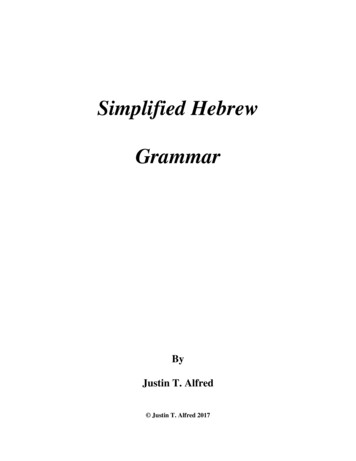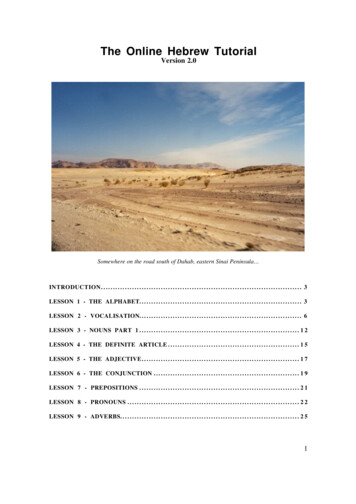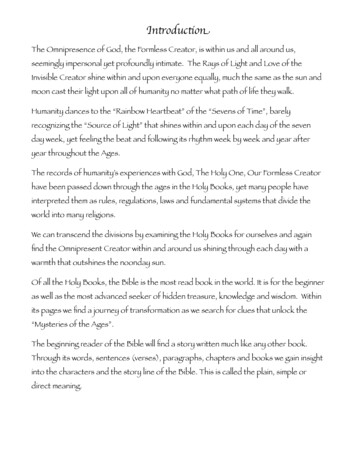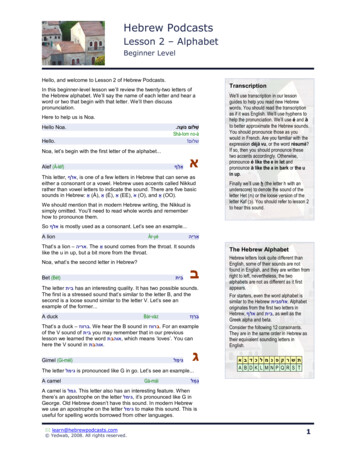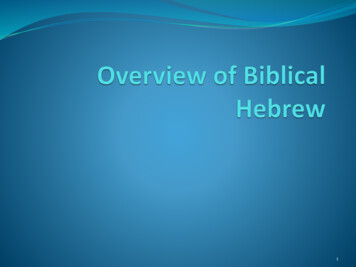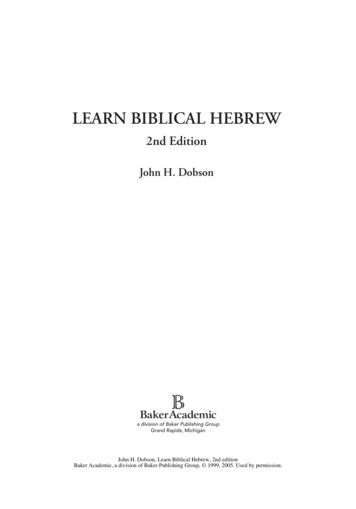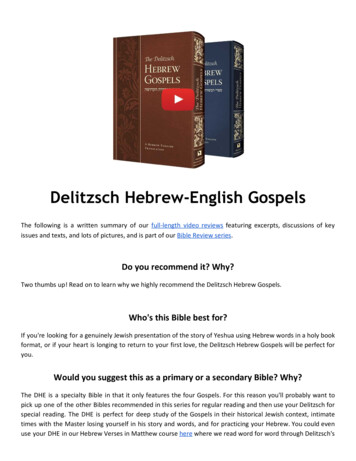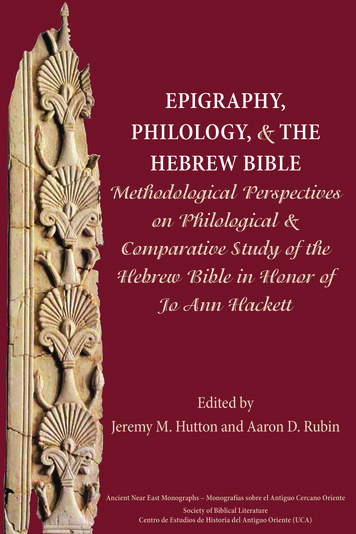
Transcription
Epigraphy,Philology, & theHebrew BibleMethodological Perspectiveson Philological &Comparative Study of theHebrew Bible in Honor ofJo Ann HackettEdited byJeremy M. Hutton and Aaron D. RubinAncient Near East Monographs – Monografías sobre el Antiguo Cercano OrienteSociety of Biblical LiteratureCentro de Estudios de Historia del Antiguo Oriente (UCA)
EPIGRAPHY, PHILOLOGY, AND THE HEBREW BIBLE
Ancient Near East MonographsGeneral EditorsEhud Ben ZviRoxana FlamminiAlan LenziJuan Manuel TebesEditorial Board:Reinhard AchenbachEsther J. HamoriSteven W. HollowayRené KrügerSteven L. McKenzieMartti NissinenGraciela Gestoso SingerNumber 12
EPIGRAPHY, PHILOLOGY, AND THEHEBREW BIBLEMethodological Perspectives on Philological and Comparative Study ofthe Hebrew Bible in Honor of Jo Ann HackettEdited byJeremy M. Hutton and Aaron D. RubinSBL PressAtlanta
Copyright 2015 by SBL PressAll rights reserved. No part of this work may be reproduced or transmitted in any formor by any means, electronic or mechanical, including photocopying and recording, or bymeans of any information storage or retrieval system, except as may be expressly permitted by the 1976 Copyright Act or in writing from the publisher. Requests for permissionshould be addressed in writing to the Rights and Permissions Office, SBL Press, 825 Houston Mill Road, Atlanta, GA 30329 USA.Library of Congress has catologued the print edition:Names: Hackett, Jo Ann, honouree. Hutton, Jeremy Michael, editor. Rubin,Aaron D., 1976- editor.Title: Epigraphy, philology, and the Hebrew Bible : methodologicalperspectives on philological and comparative study of the Hebrew Bible inhonor of Jo Ann Hackett / edited by Jeremy M. Hutton and Aaron D. Rubin.Description: Atlanta : SBL Press, 2015. Series: Ancient Near Easternmonographs ; Number 12 Includes bibliographical references and index.Identifiers: LCCN 2015024874 ISBN 9780884140795 (pbk. : alk. paper) ISBN9780884140801 (ebook) ISBN 9780884140818 (hardcover : alk. paper)Subjects: LCSH: Semitic languages, Northwest. Semitic philology. Bible.Old Testament--Language, style.Classification: LCC PJ4121 .E65 2015 DDC 492/.045--dc23LC record available at http://lccn.loc.gov/2015024874Printed on acid-free paper.
CONTENTSAbbreviations . viiIntroductionJeremy M. Hutton and Aaron D. Rubin . 1PART 1: PHILOLOGYDeir All as a Canaanite Dialect: A Vindication of HackettNa‘ama Pat-El and Aren Wilson-Wright . 13Biblical Hebrew Nominal PatternsJohn Huehnergard . 25Style-Switching in Biblical HebrewGary A. Rendsburg . 65The Aramaic Root ‘To Go’— HWK or HLK?Jason A. Bembry . 87Translation Technique in Targum Onqelos: The Rendering of Hebrew Steven E. Fassberg . 97Inscribed in VocalityF. W. Dobbs-Allsopp . 109PART 2: EPIGRAPHYTwo Methodological Issues Concerning the Expanded Collection of EarlyAlphabetic TextsGordon J. Hamilton . 127The Scribal Art at UgaritJohn L. Ellison . 157
vi “Observe Due Measure”: The Gezer Inscription and Dividing a Trip around theSunJacqueline Vayntrub. 191Field of View: Northwest Semitic Palaeography and Reflectance TransformationImaging (RTI)Nathaniel E. Greene and Heather Dana Davis Parker . 209The Ivory Pomegranate: The Anatomy of a Probable Modern ForgeryChristopher A. Rollston . 237Interpreting Translation Techniques and Material Presentation in BilingualTexts: Initial Methodological ReflectionsJeremy M. Hutton and Catherine E. Bonesho. 253PART 3: ISRAELITE RELIGION AND THE HEBREW BIBLEIsraelite Religion as Communication: An Essay on MethodMark W. Hamilton . 295Vowing Women: Personal Religion, Gender, and PowerSusan Niditch . 329Biblical d m and Mesopotamian Adapa as “Primal Human”: A CognitiveApproachDexter E. Callender Jr. . 343Index of Ancient Texts . 373Index of Modern Authors . 385
bBibEncBibIntBibOrBJPESBSOASBTSBZAWfirst personsecond personthird personAnnual of the American Schools of Oriental ResearchÄgypten und Altes TestamentAnchor BibleAnchor Bible DictionaryAbr-NahrainArchaeology and Biblical StudiesAcademia BiblicaAncient Israel and Its LiteratureAmerican Journal of Semitic Languages and LiteraturesAbhandlungen für die Kunde des MorgenlandesAbhandlungen zur Literatur Alt-Syrien-Palästinas und MesopotamiensAlter Orient und Altes TestamentAmerican Oriental StudiesAramaic StudiesAmerican Schools of Oriental Research Monograph SeriesAbhandlungen zur Theologie des Alten und Neuen TestamentsAndrews University Seminary StudiesBiblical ArchaeologistBulletin of the American Schools of Oriental ResearchBrown, Francis, S. R. Driver, and Charles A. Briggs. A Hebrew and English Lexicon of the Old Testament. 2nd ed. Oxford: Clarendon Press, 1951Bibliotheca Ephemeridum Theologicarum LovaniensiumBiblicaBiblical EncyclopediaBiblical InterpretationBiblica et orientaliaBulletin of the Jewish Palestine Exploration SocietyBulletin of the School of Oriental and African StudiesBiblical Tools and StudiesBeihefte zur Zeitschrift für die Alttestamentliche Wissenschaft
viii iers de Revue bibliqueContributions to Biblical Exegesis and TheologyCatholic Biblical QuarterlyCatholic Biblical Quarterly Monograph SeriesCulture and History of the Ancient Near EastCultural Heritage ImagingA Corpus of Ammonite Inscriptions. Walter E. Aufrecht.Lewiston: Edwin Mellon, 1989Corpus Inscriptionum Iudaeae/Palaestinae, vol. I: Jerusalem,part 1. Edited by Hannah M. Cotton et al. Berlin: de Gruyter,2010Corpus inscriptionum latinarumCorpus inscriptionum semiticarumCuneiform MonographsConiectanea Biblica: Old Testament SeriesThe Context of Scripture. Edited by William W. Hallo. 3 vols.Leiden: Brill, 1997–2002Comptes rendus de l’Académie des inscriptions et belleslettresDictionary of Classical Hebrew. Edited by David J. A. Clines.9 vols. Sheffield: Sheffield Phoenix Press, 1993–2014Descriptive Translation StudiesDictionary of the North-West Semitic Inscriptions. JacobHoftijzer and Karel Jongeling. 2 vols. Leiden: Brill, 1995Dictionary of the Targumim, Talmud Babli, Yerushalmi andMidrashic Literature. Marcus Jastrow. New York: JudaicaPress, 1971. Repr., 1996A Dictionary of the Ugaritic Language in the Alphabetic Tradition. Gregorio del Olmo Lete and Joaquín Sanmartín. 2ndrevised ed. 2 vols. Handbook of Oriental Studies, section 1,vol. 67. Leiden: Brill, 2004El-Amarna tablets. According to the edition of J. A. Knudtzon.Die el-Amarna-Tafeln. Leipzig: Hinrichs, 1908–1915. Reprint,Aalen: Zeller, 1964. Continued in A. F. Rainey, El-AmarnaTablets, 359–379. 2nd revised ed. AOAT 8. Kevelaer: Butzonund Bercker, 1978Ephemeris Epigraphica: Corpus Inscriptionum LatinarumSupplementum. 9 vols. Rome: Institutum and Berlin: G.Reimer, 1872–1913Encyclopedia of Hebrew Language and LinguisticsEncyclopedia Judaica. Edited by Fred Skolnik and MichaelBerenbaum. 2nd ed. 22 vols. Detroit: Macmillan ReferenceUSA, 2007feminine
QRJSJSupJSOTixForschungen zum Alten TestamentForschungen zur Religion und Literatur des Alten und NeuenTestamentsThe Hebrew and Aramaic Lexicon of the Old Testament.Ludwig Koehler, Walter Baumgartner, and Johann J. Stamm.Translated and edited under the supervision of Mervyn E. J.Richardson. 4 vols. Leiden: Brill, 1994–1999Hebrew BibleHebrew Bible and Ancient IsraelHandbuch der Nordsemitischen Epigraphik. Mark Lidzbarski.Weimar: Emil Felber, 1898Hebrew StudiesHarvard Semitic MonographsHarvard Semitic StudiesHarvard Theological ReviewAn Introduction to Biblical Hebrew Syntax. Bruce K. Waltkeand Michael O’Connor. Winona Lake, IN: Eisenbrauns, 1990Israel Exploration JournalInscriptions grecques et latines de la Syrie, vol. XVII.1: Palmyre. Bibliothèque archéologique et historique 195. JeanBaptiste Yon. Beirut: Institut Français du Proche-Orient, 2012Inscriptiones Latinae Selectae. Edited by Hermann Dessau. 5vols. Berlin: Weidmann, 1892–1916.InterpretationIsrael Oriental StudiesIscrizioni puniche della Tripolitania (1927–1967). GiorgioLevi Della Vida and Maria Giulia Amadasi Guzzo. Monographie di Archeologia Libica 22. Rome: Bretschneider, 1987The Inscriptions of Roman Tripolitania. Joyce Maire Reynoldsand John Bryan Ward-Perkins. Rome: British School at Rome,1952Journal AsiatiqueJournal of the American Academy of ReligionJournal of the Ancient Near Eastern Society of Columbia UniversityJournal of the American Oriental SocietyJournal of Biblical LiteratureJournal of Cuneiform StudiesJournal of Hebrew ScripturesJournal of Jewish StudiesJournal of Near Eastern StudiesJournal of Northwest Semitic LanguagesJewish Quarterly ReviewJournal for the Study of Judaism: Supplement SeriesJournal for the Study of the Old Testament
x tJournal for the Study of the Old Testament: Supplement SeriesJournal for the Study of the PseudepigraphaJournal of Semitic StudiesJournal for the Scientific Study of ReligionKanaanäische und aramäische Inschriften. Herbert Donnerand Wolfgang Rölling. 3 vols. Wiesbaden: Harrassowitz,1962–2002Kleine Untersuchungen zur Sprache des Alten Testaments undseiner UmweltThe Library of Hebrew Bible/Old Testament StudiesLinguistic Studies in Ancient West SemiticSeptuagintmasculineMasoretic TextNear Eastern ArchaeologyNorthwest SemiticOxford English DictionaryOrbis Biblicus et OrientalisOriens et OccidensOrientalia lovaniensia analectaOrientaliaOudtestamentische StudiënPalmyrene Aramaic Texts. Delbert R. Hillers and EleonoraCussini. Publications of The Comprehensive Aramaic LexiconProject. Baltimore: The Johns Hopkins University Press, 1996Palestine Exploration Fund Quarterly StatementPalestine Exploration QuarterlypluralPlautuspersonal namePoenulusProoftextsRevue bibliqueResources for Biblical StudyCollingwood, R. G., and R. P. Wright, eds. The Roman Inscriptions of Britain, 2 vols. Oxford: Clarendon, 1965–1995Revista degli studi orientaliReflectance Transformation ImagingSociety of Biblical Literature Dissertation SeriesScripta HierosolymitanaSemeia StudiessingularStudies in Semitic Languages and Linguisticssource textStudies in Biblical Literature
YCSZAZAHZAWZDMGZDPVZPExiStudies on the Texts of the Desert of JudahSubsidia BiblicaTel AvivTheological Dictionary of the Old Testament. Edited by G.Johannes Botterweck and Helmer Ringgren. Translated byJohn T. Willis et al. 8 vols. Grand Rapids: Eerdmans, 1974–2006target languageTheologische LiteraturzeitungTheologische Rundschautarget textUgarit-ForschungenVeröffentlichungen der Orientalischen Kommission der Akademie der Wissenschaften und der Literatur, MainzVetus Testamentum SupplementsWissenschaftliche Monographien zum Alten und Neuen TestamentDie Welt des OrientsWest Semitic Research ProjectWissenschaftliche Untersuchungen zum Neuen TestamentYale Classical StudiesZeitschrift für AssyriologieZeitschrift für AlthebräistikZeitschrift für die alttestamentliche WissenschaftZeitschrift der deutschen morgenländischen GesellschaftZeitschrift des deutschen Palästina-VereinsZeitschrift für Papyrologie und Epigraphik
Jo Ann Hackett with DarwinPhoto by Walter E. AufrechtUsed with Permission
Introduction:Honoring the Pedagogical Legacy ofProfessor Jo Ann HackettJeremy M. HuttonUniversity of Wisconsin–MadisonandAaron D. RubinPennsylvania State UniversityThe present volume comprises a set of contradictions. It is simultaneously aFestschrift—usually conceived as a collection of essays honoring a colleague,teacher, and friend—and a volume designed with the graduate classroom inmind and organized around a few common themes. And whereas a few of theessays are typical exemplars of the genre of “introductory” or “overview” essayand reflecting engagement with the wider approaches to the disciplines at hand,many of the articles herein are specialized papers featuring a theoretical ormethodological orientation appropriate to specific modes of study. This format,then, does not fit easily within any of the genres that are common within thefields of Biblical Studies and Northwest Semitic Philology. Yet, the constituentessays of this volume have been composed with two purposes: First, despitetheir eclectic and broadly-interested diversity of topics, these papers all attemptto grapple with specific problems associated with one of three topics that Professor Jo Ann Hackett has devoted her career to understanding: philological studyof the Northwest Semitic languages; the study of epigraphic exemplars of thosesame languages; and the religious traditions of Israel and its neighbors in theSouthern Levant, as reconstructed from the perspective(s) offered in the HebrewBible. Secondly, these articles are all oriented towards the educational context ofgraduate-level students of these same fields of study. These complementarygoals are modeled on both the research and pedagogical work of ProfessorHackett.When we first began to conceptualize the most fitting way to honor Professor Hackett’s professional legacy, we were certain that some standard features ofFestschriften remained relevant: we wanted to present in Professor Hackett’shonor a collection of high-level essays that allowed a distinguished group ofscholars to present their most recent work on themes that were generally conso-
2JEREMY M. HUTTON AND AARON D. RUBINnant with those that Professor Hackett has written upon so eloquently in her owndistinguished career. For this reason, we chose the three-fold rubric of epigraphy, philology, and Israelite religion as the touchstones of the essays. At thesame time, we attempted to avoid several of the commonly-voiced criticisms ofFestschriften: they are too scattered, with essays departing far afield from thecentral interests of the honoree; they lack a cohesive sense of pushing theboundaries of the field, with contributors often retreating into their comfortzones, outlining or restating previous works; and, relatedly and most distastefulto potential publishers, they have no single utilitarian value—their academicscatteredness and typically massive size (and, correspondingly, their often painful cost) make them virtually unsellable except to the small coterie of colleaguesand students wishing to honor the legacy of the celebrated scholar. In order tocombat these oft-cited deficiencies of Festschriften, we decided on a model thatwe hope will prove useful for a wider range of scholars.Two useful innovations move this book from a straightforward categorization as a Festschrift into a less-well-defined rubric that possesses benefits for usein the classroom. First, we invited contributions from selected individuals withan eye towards compiling a book that presents a variety of topics—both moregeneral and more advanced, more traditional and more cutting edge—comprising a cross-section of the studies currently being undertaken in Northwest Semitic philology. Secondly (and relatedly), we departed from the standardmodel of Festschriften in which it is mostly established colleagues—and only afew of the honoree’s students—who are invited to contribute. Although a bookfull of essays by all of Professor Hackett’s friends and colleagues could easilyhave filled many more pages than encompassed in the current volume, we optedfor a more streamlined, more innovative format. In this book, Professor Hackett’s former students and Doktorkinder (Bembry, Callender, Ellison, G. J. Hamilton, M. Hamilton, Hutton, Pat-El, and Wilson-Wright)—and even futureDoktorgrosskinder (Bonesho and Greene)—have authored a relatively largeproportion of the essays. Two of the invitees—Parker and Vayntrub—were invited on the strength and innovation of their scholarship rather than on the basisof any personal connection to Professor Hackett (although the latter has servedon an SBL steering committee with the honoree). This divergence from commonFestschrift practice allowed us to introduce readers to pioneering fields of studythat might otherwise have gone un- or underrepresented.In addition to these structural innovations, we consciously designed thisbook to honor the pedagogical legacy that Professor Hackett has established inher decades of service as assistant professor in the Department of Religion atOccidental College (1979–1984); visiting lecturer at Weston School of Theology and Harvard University (1984–1985); Mellon Scholar in the Dept. of NearEastern Studies at Johns Hokins University (1985–1986); assistant professor inthe Dept. of Religious Studies at Indiana University (1986–1990); Professor ofthe Practice of Biblical Hebrew and Northwest Semitic Epigraphy in the Department of Near Eastern Languages and Civilizations at Harvard University(1990–2009); and, now, Professor in the Departments of Middle Eastern Studies
INTRODUCTION3and Religious Studies at the University of Texas, Austin (2009–present). Professor Hackett’s work in the classroom has positioned her as a consummate teacher, and it is this aspect of her work that we most wish to honor by assembling agroup of essays that both exemplify traditional approaches and employ new theoretical frameworks in researching the Northwest Semitic languages and theirassociated texts and religious traditions. Moreover, our selection of the Societyof Biblical Literature’s Ancient Near Eastern Monograph series, of which a substantial benefit is its distribution in the form of open access PDF files, permits awider readership, both in the graduate classroom and by researchers at large,than is typically the case for sparsely disseminated specialist volumes. We believe that this volume’s suitability to the graduate classroom—due to both itscontent and the medium in which it appears—will facilitate its wider acceptanceand application in the field as a whole. If cost-effectiveness and breadth of dissemination benefit pedagogical methodology, this unconventional medium willadd further value to the book’s contents.Professor Hackett is well trained to investigate a variety of subjects, havingearned her PhD from Harvard University under the luminaries Frank MooreCross and Thomas O. Lambdin. The breadth of her capabilities spans from theearly history of Biblical Hebrew and the other Northwest Semitic languages tothe religious rituals associated with child sacrifice. These two interests werecombined in her doctoral dissertation, subsequently published as The BalaamText from Deir All .1 In that study, Professor Hackett argued that the dialectfound in the Deir All inscription should be regarded as closer in type to Canaanite than to Aramaic,2 although she has more recently expressed some reticence to continue this identification in light of the discovery of the Tel Dan Inscription (and its attestation of the yaqtul-preterit in Aramaic) and other arguments for Tel Dan as a dialect of Northwest Semitic that did not share in manyof the specific innovations distinguishing Canaanite and Aramaic from theirmother language, Proto-Northwest Semitic.3 Na‘ama Pat-El and Aren WilsonWright challenge the general consensus, arguing here in favor of ProfessorHackett’s original categorization in their chapter, “Deir All as a CanaaniteDialect: A Vindication of Hackett” (ch. 1). They do so on the basis of two linguistic isoglosses that the Deir All inscriptions share with the (other) Canaan1. Jo Ann Hackett, The Balaam Text from Deir All , HSM 31 (Chico, CA: ScholarsPress, 1984); see also eadem, “The Dialect of the Plaster Text from Tell Deir All ,” Or53 (1984): 57–65.2. Eadem, Balaam Text, 124.3. Personal communication with J. M. Hutton. For the view of the dialect as an otherwise undifferentiated form of NWS, see John Huehnergard, “Remarks on the Classification of the Northwest Semitic Languages”; P. Kyle McCarter, “The Dialect of the DeirAlla Texts”; and Dennis Pardee, “The Linguistic Classification of the Deir Alla TextWritten on Plaster,” all in The Balaam Text from Deir Alla Re-Evaluated: Proceedingsof the International Symposium Held at Leiden 21–24 August 1989, ed. Jacob Hoftijzerand Gerritt van der Kooij (Leiden: Brill, 1991), respectively, 282–93, 87–99, esp. 97; and104–5.
4JEREMY M. HUTTON AND AARON D. RUBINite dialects: “a relative pronoun derived from a grammaticalized form of * a ar‘place’” and “a systematic morphological and syntactic distinction between theinfinitive absolute and the infinitive construct in the G stem” (p. 19).Professor Jo Ann Hackett served for eighteen years as Director of the Biblical Hebrew program in the Department of Near Eastern Languages at HarvardUniversity, and has authored a textbook designed to guide students through thebasic grammar of Biblical Hebrew in a single semester.4 As a result of the rigorand precision with which she executed these duties, Professor Hackett is wellregarded in Biblical Hebrew pedagogical circles. But not only is she regarded byher colleagues and former students (of which group both Rubin and Hutton aremembers) as an excellent instructor; her students have typically achieved excellence in the classroom as well—a fact measured in part by the widespread distribution of her students in academic stations. As director of the Biblical Hebrewprogram at Harvard University, Jo Ann oversaw countless hours of translationfrom Hebrew to English (not to mention English to Biblical Hebrew), and mentored scores of teaching assistants and teaching fellows in courses such as Introductory Biblical Hebrew, Intermediate Biblical Hebrew, the ominously titled“Rapid Reading,” and the downright terrifying “Turbo-Hebrew”. The curriculum that Professor Hackett was beginning to implement at Harvard with “TurboHebrew” along with Professor John Huehnergard, her husband and sometimeco-author, continues to be followed at the University of Texas, Austin, wheredoctoral students read the entire Hebrew Bible during their time in coursework.In each one of these classroom settings, Professor Hackett is patient but stern;she demands grammatical precision combined with a fluid translation. Huttonrecalls that once, after a particularly offensive butchering of a passage in 1 Sam14, in which he translated the defeat (makk ) with the modifier ‘great’ (assuming g dôl ), Professor Hackett forced him to concede that, “well, the battlewasn’t that great.” Jo Ann’s sharp eye and blistering wit provides her studentsan exceptional model and exacting instructor throughout the several requiredsemesters of Biblical Hebrew, Ugaritic, and Northwest Semitic Epigraphy.Professor Hackett’s rigorous research in the philological study of BiblicalHebrew and her longstanding tradition of excellence in Northwest Semitic language instruction is honored in several essays in this volume.John Huehnergard provides a summary of Hebrew nominal morphology,tracing Hebrew lexemes to their underlying Proto-Northwest Semitic forms andconsolidating the semantic patterns resulting from this study (ch. 2). This chapter comprises a thorough reworking of the section on nominal morphology in theunpublished, and long-anticipated (and often surreptitiously photocopied) “Outline of Historical Hebrew Grammar” that Huehnergard co-authored with his andProfessor Hackett’s mentor at Harvard, Thomas O. Lambdin.Gary A. Rendsburg surveys biblical uses of dialect shifting in order to capture and render more realistically geographic or social details (ch. 3). The inves4. Jo Ann Hackett, A Basic Introduction to Biblical Hebrew (Peabody, MA: Hendrickson, 2010).
INTRODUCTION5tigated texts therefore comprise literary exemplars of the phenomenon known as“style-switching” in modern socio-linguistic studies.Jason A. Bembry investigates the epigraphic and biblical occurrences of theAramaic verbs apparently derived from the roots HWK and HLK, attemptingto determine the historical origination of the former. Bembry argues that thelatter root served as the source of the former, which underwent a process whereby the medial *l was lost, on analogy with the semantically related and phonologically similar SLQ in Aramaic (ch. 4).F. W. “Chip” Dobbs-Allsopp takes an unconventional approach to the issueof ancient written Hebrew poetry. He analyzes written poetry as “emergent,” inthat the technology of writing was first employed only imperfectly, inchoativelyto capture Hebrew poetry. Dobbs-Allsopp problematizes this interface of thegraphic nature of writing and the auditory modes of poetic recitation; without anappreciation of the unique matrix of poetic orality that underlies and informs thewritten biblical text, our understanding of biblical poetry remains incomplete(ch. 6).Jo Ann’s tough but forgiving guidance also served as a model for many ofher students through several semesters of teaching under her supervision. Beforeneophyte language instructors embarked on each of their teaching posts, Jo Ann(and Professor Beverly Kinzele of the Harvard Divinity School) engaged themin several sessions on second language acquisition. It was in these sessions thatmost students were first introduced to the problems associated with translationas objects worthy of consideration in their own right. Jo Ann never pursued theproblems raised at these sessions at the theoretical level, preferring instead todeal with them as pragmatic matters related to second language instruction in amodern institutional setting. However, two of the essays in the present volumedeal explicitly with issues associated with the phenomenon of translation.Steven E. Fassberg investigates the lexical correspondences in evidence between the (Hebrew) Masoretic Text and the (Aramaic) Targum Onqelos, specifically as regards the verbs meaning ‘to walk.’ In contrast to Bembry (see above),Fassberg concludes that HWK comprised a root separate from HLK, and thatthe two demonstrate a complicated and overlapping pattern of distribution alongwith ZL (ch. 5). Although the essays by Bembry and Fassberg arrive at almostdiametrically opposed conclusions, we regard this as an homage to the kind ofdebate that Professor Hackett encourages in her own graduate classes.As Jeremy Hutton and Catherine Bonesho have demonstrated in their paper,the pragmatic issues of translation extend far back in time. One task with whichSemitic Philology has not sufficiently grappled is the formulation of theoreticalapproaches through which modern researchers can understand how translators inantiquity conceived of and practiced their craft—including the material considerations governing what counts as a “translation” (ch. 12).Another component of Professor Hackett’s research and teaching dutiescomprised the study of Northwest Semitic epigraphy. This focus of ProfessorHackett’s career is honored in several essays dealing directly with epigraphictexts in Proto-Canaanite, Ugaritic, Phoenician, and Hebrew.
6JEREMY M. HUTTON AND AARON D. RUBINGordon J. Hamilton explores two methodological principles governing thevalidity of epigraphic studies. First, Hamilton espouses a “temporally-forward”analysis of typology, in which researchers utilize the growing corpus of earlylinear inscriptions as a basis of comparison.5 Second, he cautions against anover-hasty move from the palaeographic analysis of an inscription to its linguistic analysis. Hamilton views this tendency among modern epigraphers as beingfueled by advances in communicative technology as well (ch. 7).A similarly meticulous analysis of palaeography is carried out by John L.Ellison, who studies “The Scribal Art at Ugarit.” Employing a process that canonly be described as “experiential epigraphy” (following the terminology ofJohn Edmondson),6 Ellison demonstrates that the implements and procedures ofUgaritic scribal culture are recoverable. Fittingly, this essay condenses much ofEllision’s expansive dissertation, which he completed under Professor Hackett’stutelage, and we are pleased to present this study here (ch. 8).7In her study of the Gezer Inscription (now commonly recognized as exemplifying Phoenician language and scribal character), Jacqueline Vayntrubdemonstrates how vital it is that epigraphic study be tempered with and complemented by an anthropologically informed investigation. In so doing, she reanalyzes the “calendar’s” genre, assigning it instead to the wider rubric of “Wisdom Literature,” since it serves to “tr
DCH Dictionary of Classical Hebrew. Edited by David J. A. Clines. 9 vols. Sheffield: Sheffield Phoenix Press, 1993–2014 DTS Descriptive Translation Studies DNWSI Dictionary of the North-West Semitic Inscriptions. Jacob Hoftijzer and Karel Jongeling. 2 vols. Leiden: Brill, 1995 DTTML Dictiona



